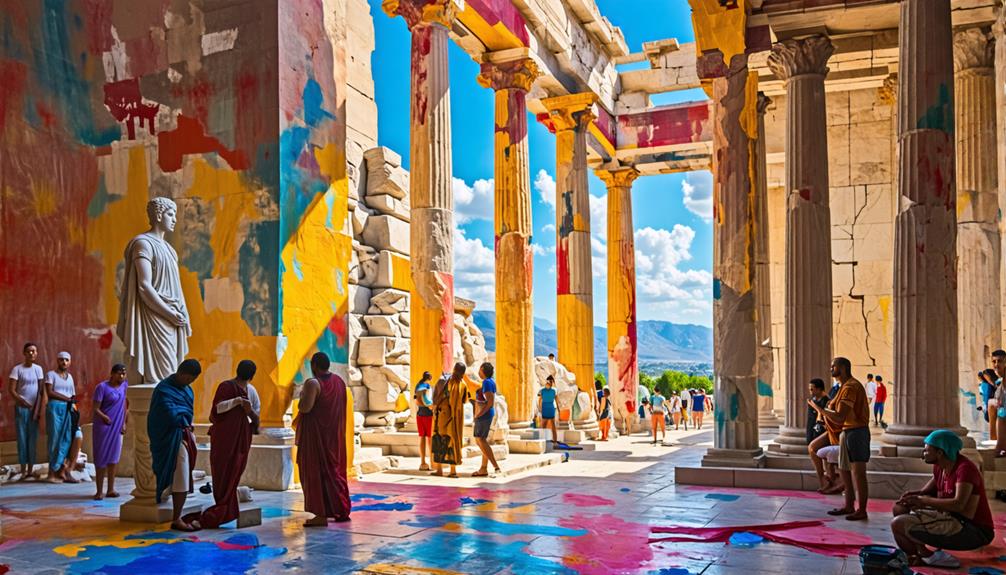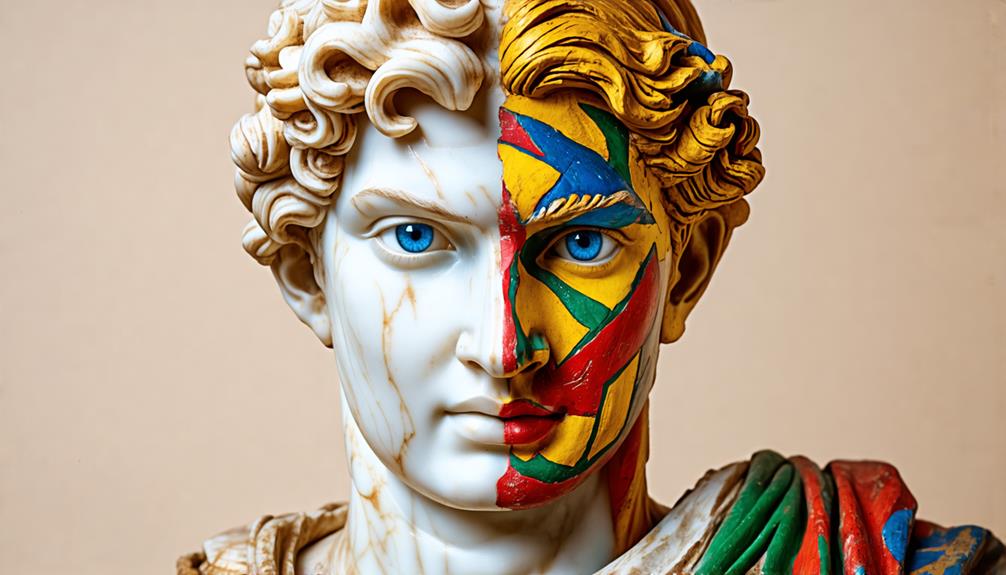You've likely seen countless images of pristine white Greek and Roman sculptures, but what if you discovered that these ancient masterpieces were originally a riot of color? Recent research has shattered the long-held belief that classical sculptures were meant to be stark and monochromatic. Instead, evidence suggests that vibrant pigments once adorned these works, bringing them to life in ways we've only begun to imagine. This revelation not only changes our perception of ancient art but also challenges our understanding of the cultures that created them. What other misconceptions about the ancient world might be waiting to be uncovered?
Key Takeaways
- Archaeological evidence reveals ancient Greek and Roman sculptures were originally painted in vibrant colors.
- Sophisticated imaging techniques have uncovered traces of pigments like Egyptian blue on marble statues.
- The misconception of pure white sculptures stems from 19th-century biases linking whiteness to artistic superiority.
- Colorful sculptures conveyed cultural narratives and enhanced visibility in public spaces of ancient societies.
Unveiling Ancient Polychromy

Contrary to popular belief, the pristine white marble of ancient Greek and Roman sculptures once burst with vibrant colors, a revelation that's reshaping our understanding of classical art.
Archaeological discoveries have uncovered traces of pigments like lead white and Egyptian blue on these ancient Greek sculptures, challenging the long-held perception of pure white statuary.
Vinzenz Brinkmann's groundbreaking research, utilizing advanced imaging techniques, has brought the polychromy of classical sculptures to light, leading to exhibitions like 'Gods in Color.'
This discovery has exposed historical biases, particularly from 19th-century scholars who associated whiteness with artistic superiority.
Modern technological advancements, such as X-ray fluorescence analysis, have enabled better identification of ancient pigments, prompting a reevaluation of classical art's historical narrative.
As you explore these findings, you'll gain a new appreciation for the vibrant world of ancient sculpture.
Techniques for Color Detection
To uncover the hidden colors of ancient sculptures, archaeologists and art historians employ a range of sophisticated techniques that go far beyond the naked eye.
Experts use infrared light and X-ray fluorescence to detect traces of color and analyze pigments' chemical composition.
Raking light and UV photography, pioneered by researchers like Vinzenz Brinkmann and Ulrike Koch-Brinkmann, reveal hidden layers of polychromy on statues.
The British Museum's use of red light analysis has even identified Egyptian blue on ancient works.
These methods, combined with the study of paint fragments and ancient texts like Pliny the Elder's 'Naturalis historia,' allow for accurate reconstruction of original hues.
Cultural Implications of Colorful Sculptures

You might be surprised to learn that our modern perception of ancient Greek and Roman sculptures as pristine white marble has profoundly shaped cultural attitudes and misconceptions about classical antiquity.
Johann Winckelmann's ideas linked white marble to artistic restraint and racial superiority, overshadowing the vibrant colors and polychromy that originally adorned these sculptures.
In reality, the use of vibrant colors in ancient Greek sculptures served to convey cultural narratives and enhance visibility in public spaces.
Recent discoveries challenge the notion of racial homogeneity in antiquity, revealing that multiethnic societies were reflected in diverse color palettes.
The debate over colorful reconstructions highlights the tension between historical authenticity and modern tastes.
Conclusion
You've discovered a hidden world of color in ancient art.
As you explore this revelation, you're challenging long-held assumptions about classical aesthetics.
You're now seeing these sculptures as their creators intended: vibrant, lifelike, and culturally rich.
This new perspective isn't just about art history; it's reshaping your understanding of ancient societies.
Remember, when you look at these works, you're not just seeing stone—you're glimpsing a colorful past that's been waiting to be rediscovered.

Leave a Reply